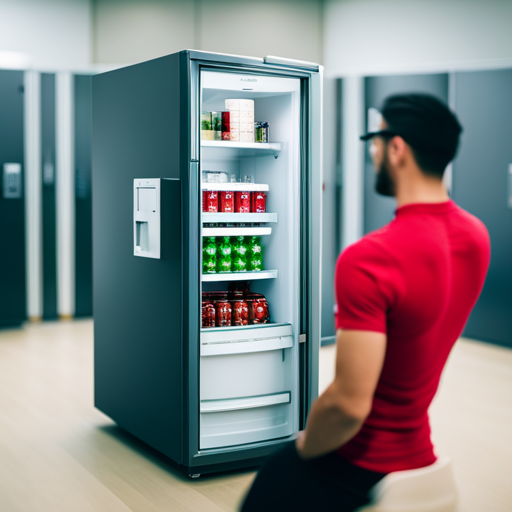Do you rely on your refrigerator filter to remove impurities from your drinking water? If so, you may be surprised to learn that most fridge filters do not effectively remove fluoride.
Fluoride is a mineral found in water and soil that is often added to public water supplies to prevent tooth decay. While it may seem like a beneficial additive, some people have concerns about the long-term effects of fluoride consumption.
In this article, we’ll explore the surprising truth about fluoride removal and provide information on alternative filtration methods for those concerned about their water’s fluoride content.
We’ll start by discussing the basics of fluoride and why it’s added to water supplies. Then, we’ll dive into how filters work and which types of filters are most effective at removing fluoride.
Finally, we’ll provide considerations and alternatives for those looking to reduce their fluoride exposure. Whether you’re a concerned parent or just want to make sure you’re drinking the purest water possible, this article will give you the information you need to make an informed decision about your water filtration system.
Key Takeaways
– Refrigerator filters sold by manufacturers only remove a small fraction of fluoride from water using activated carbon.
– In-line water filters can be used to treat refrigerator water and reduce fluoride levels effectively.
– Clearly Filtered filters are capable of removing fluoride from drinking water and meet NSF/ANSI standards for fluoride reduction.
– Fluoride is added to water supplies to prevent tooth decay and is not harmful in small amounts, but high levels can cause health problems.
Fluoride Basics
You may already know that fluoride is a mineral found naturally in water and soil, and added to public water supplies to prevent tooth decay. Community water fluoridation has been shown to reduce cavities by 25% in both children and adults. The American Dental Association recommends using fluoride toothpaste, and the Environmental Protection Agency sets a maximum contaminant level for fluoride in drinking water.
While fluoride is not harmful in small amounts, high levels can cause health problems such as fluorosis. Fluorosis is a condition that causes white spots on teeth and can occur if a child ingests too much fluoride while their teeth are developing.
It’s important to note that fluoride is naturally occurring in some water sources, and levels can vary depending on location. Fluoride can also be found in toothpaste and mouthwash.
How Filters Work
Understanding how refrigerator water filters work is important in determining their ability to remove certain minerals and contaminants from your drinking water. Most filters sold by refrigerator manufacturers use activated carbon, which is effective at removing some impurities but has limitations when it comes to fluoride.
Activated carbon only removes a tiny fraction of fluoride from water, meaning that refrigerator filters can’t remove fluoride from your drinking water. If you’re concerned about the fluoride levels in your drinking water, in-line water filter options are available to treat refrigerator water.
These filters are designed specifically to reduce fluoride levels and can be installed on the water line leading to your refrigerator. While not all in-line water filters are created equal, some are very effective at removing fluoride from water. It’s important to do your research and choose a filter that meets your specific needs and budget.
Types of Filters
To learn about the different types of filters that can remove fluoride from your drinking water, consider researching and comparing options such as reverse osmosis, activated alumina, and distillation. These methods are more effective than the activated carbon filters found in most refrigerator filters.
In-line filters, which can be used to treat refrigerator water, are another option to consider. These filters use a combination of activated carbon and other media, such as activated alumina, to reduce fluoride levels in drinking water.
When comparing filters, be sure to look for independent testing results and certifications, such as NSF/ANSI standards for fluoride reduction, to ensure that the filter is effective at reducing fluoride levels in your drinking water.
Considerations and Alternatives
When looking for alternatives to refrigerator filters, it’s important to consider the effectiveness of different types of filters and their certifications for reducing fluoride levels in drinking water.
Reverse osmosis and activated alumina filters are two cost-effective alternatives that can effectively remove fluoride from water. Reverse osmosis is the most effective method, removing up to 94% of fluoride in water.
Activated alumina filters, on the other hand, typically have a lifespan of about six months and can remove fluoride from water.
It’s important to note that while fluoride is not harmful in small amounts, high levels can cause health problems. Some people may choose to remove fluoride from their drinking water for personal reasons, but it’s important to consider the impact on health.
The American Dental Association recommends using fluoride toothpaste, and the Environmental Protection Agency sets a maximum contaminant level for fluoride in drinking water. When choosing a filter to remove fluoride from drinking water, it’s important to look for certifications such as NSF/ANSI standards for fluoride reduction.
Conclusion
So, there you have it – the surprising truth about fridge filters and fluoride removal. While these filters may effectively remove some impurities from your drinking water, they likely won’t make much of a difference when it comes to fluoride.
If you’re concerned about your fluoride intake, it’s important to consider alternative filtration methods such as reverse osmosis or activated alumina filters. When choosing a filtration method, be sure to consider the cost, maintenance, and effectiveness of each option.
While some methods may be more expensive up front, they may ultimately be more cost-effective in the long run. Ultimately, the decision on how to filter your water is up to you, but it’s important to make an informed choice to ensure the health and safety of you and your family.
